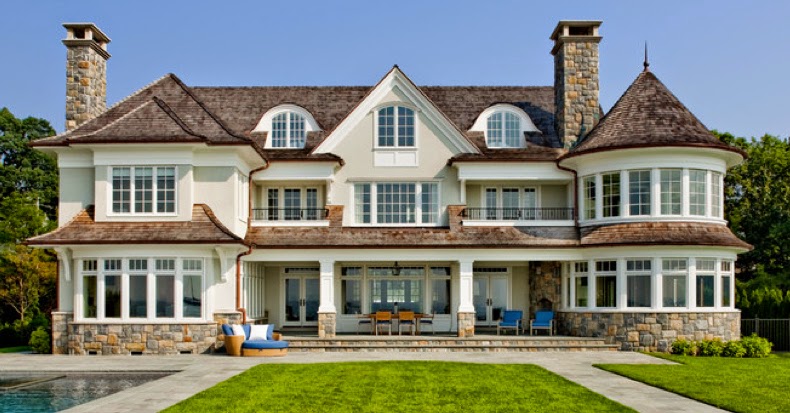Primary Solids
Primary solids consist of primary shapes that have been altered through extension or rotation in order to make them three-dimensional. For example triangles make pyramids or cones, circles make spheres and cylinders, and so on. Just because the word solid is used doesn't necessarily mean the three dimensional object is a substantial form. It can in many cases be hollow.
An example of a primary solid (pyramid) in the built environment:
The various pyramid roofs help define different wings of this house. It is a sharp design feature due to the steepness of the pyramid along with the repetition amongst the group. As you can see each pyramid roof has what appears to be sky light at the top making it not a completely whole form even though it is still considered a primary solid.
Dimensional Transformation
By changing the physical dimensions of a form you may alter the appearance of the form through dimensional transformation. Although the transformation may in some cases be drastic, the form still remains part of its original primary solid.
An example of dimensional transformation in the built environment:
The columns surrounding this house have been altered from the basic cube. Although many alterations could be possible, it is likely that an extension of the height changed its physical properties.
Subtractive Form
Other than changing its dimensions, a form can also change in appearance due to the subtraction of part of the form. Although part of the form many be deducted the form can still keep its relative shape if enough of the form is still in tact. In some cases if the change is drastic it might even be transformed into another form.
An example of a subtractive form in the built environment:
The basic form of this modern house could be classified as a rectangular prism. The bottom lower level however has been subtracted in order to make space for an outdoor living area. The forms still stays true to its relative form though. Through subtraction it has basically broken down the form into multiple rectangular prisms.
Additive Form
Even more drastic changes can be made to a solid with the addition of one or more forms in conjunction to the original. The number of additions in combination to their type and size ultimately determines whether the original solid's identity is changed. The type of addition by no means has to match the original solid. Cylinders can be added to pyramids, cubes can be added to spheres, and so on. However, in order to be unified they must be relatable in some fashion. There are many basic groupings of forms and these include: spatial tension, edge-to-edge contact, interlocking volumes, centralized form, linear form, radial form, clustered form, and grid form. Most of these are pretty self explanatory based off their name. The examples below are representations of face to face contact.
An example of additive form in the built environment:
The highlighted area within the picture is an addition to the main part of the house. The two forms make edge to edge contact. The various architectural details help tie the two buildings together.
Formal Collision of Geometry
Forms of two different types of geometry merging together will often fight for visual power. In cases like these forms may work together by suppressing their identities and creating a new form together. Other times the one might entirely encapsulate the other. Additionally, they can both retain their properties and simply share the interlocking part of their forms. Their merge might not even be within each other at times but instead with an element that connects to the geometry of one of the original elements. Often this is done to emphasize a certain part or parts of a building or space.
An example of formal collision of geometry in the built environment:
The facade below in addition to containing additive form also has formal collision of geometry. The cylindrical tower on the right breaks up the mostly straight lines and merges slightly with the right side of the house. Both forms still keep their identities.















Great explanations and examples for each of your terms. At the moment, I think my favorite technique for dimensional transformation is subtractive form because many of my favorite architectural designs have a lot of subtraction. I also agree that subtracting from a form can create a very drastic change that can be interesting and attractive.
ReplyDeleteAs usual, you went above and beyond! Your definitions were very clear and helped me understand the words better. I also really like your opening statement about form. Great job Kat!
ReplyDeleteAll the definitions are very clear to the point and well explained. The images that you brought in as examples are helping me a lot to visualize each terms. Great Job@!!:)
ReplyDelete